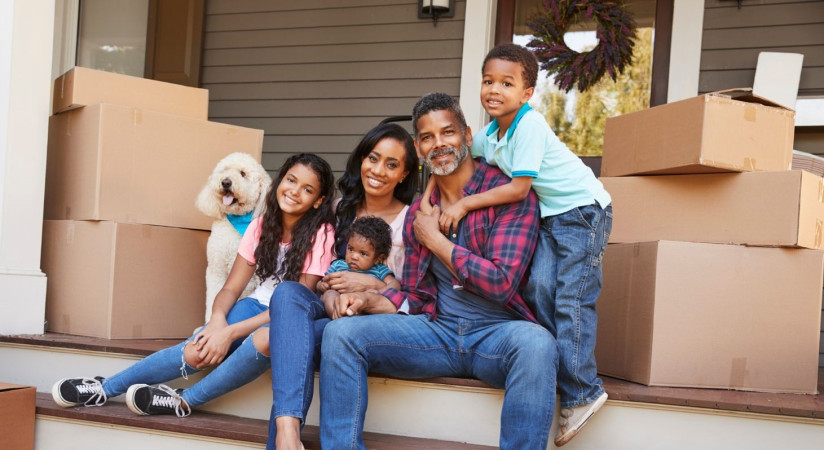Moving into a new home can be both exciting and stressful for humans and pets
While we as humans can understand and rationalize why we may have moved, canines may have a hard time adjusting to a new environment.
Luckily, there are things pet parents can do to help our canine companions adjust. Follow these tips to help your dog prepare for an upcoming move and adjust to the new place you call home.
Before Your Move
- Before moving day, take time (ideally daily) to practice short training exercises and reinforce basic obedience commands with your dog. This will increase your dog’s focus on you and help your dog feel secure in your presence during and post-moving day.
- Confine your dog in a crate or small, comfortable area of the home during packing and unpacking. Provide stimulation activities and comfort items, like toys and/or bones, to help keep your dog calm and occupied amid all the activity in the house.
- Don’t forget to take breaks and provide your dog with some mental and physical exercise, like a short training session, an on-leash walk, or a fun game.
- If you anticipate a hectic moving day, consider boarding your dog at a comfortable daycare, kennel, or friend or family member’s house. This will not only decrease your dog’s potential for anxiety, but also keep your pet safe.
Arriving at Your New Home
- Check your new home’s surroundings for any dangerous items to your dog, such as pest poisons, antifreeze, poisonous plants, chewable objects, and holes in a fenced area.
- Take your dog for a leashed walk both inside and outside of your new home when you arrive. Keep your dog confined in a room or crate to ensure their safety while you are busy unpacking.
- Plan to be home with your dog for the first few days after the move but start to practice separation. Spend time in a different room and then short periods of time away from the house, slowly increasing the amount of time your dog is home alone in a new residence.
- There may be issues with your dog toileting in the new home to mark territory (especially if there were pets in the house previously). Consider a professional cleaning by a licensed professional or replacing carpets and be patient with your dog. The best way to handle accidents is to prevent them – the more you can monitor your dog and, if necessary, restrict access to a small part of your home, the less of a chance for them to make mistakes.
- Resist buying new items for your dog and instead continue to use the same high-value items as prior to your move, like feeding bowls, toys, crates, or beds. While new items in a new home may seem like a fun idea, keeping continuity for your dog will help with them adjust to a new environment. Place the items in the same rooms (or as close as possible) as your previous home to help with the transition.
- Observe your dog’s behavior for signs of stress or trauma, like pacing, hiding, destruction, or separation anxiety, which can be triggered by a significant move. While some of these behaviors can be addressed with training, others may require veterinary treatment, such as not eating, diarrhea, and coughing.
Things to Consider About Your Dog’s Transition
- Be patient! Your dog needs time to adjust to a new living arrangement, including possible time and climate changes. Your dog is always taking cues from you and your family members, so if you are calm and comfortable in your new environment, your dog is more likely to be the same.
- Don’t overcompensate. Behavior changes are common after a big change in a dog’s life. Your dog may be uncharacteristically timid in their new surroundings, perhaps showing signs of nervousness or needy behavior. You are your dog’s most familiar anchor in this new environment, so while it might be hard, try not to overly reassure them.
- Remain calm and confident, and keep your dog occupied and focused using training time, walks, toys, and bones. You can inadvertently communicate that there is something for your dog to worry about by giving them an unusual amount of attention when they are stressed – you can also reinforce unwanted behavior unintentionally by giving love and praise during stressful times.
- Consistency is key! It will typically take about three weeks for a dog to become accustomed to a new environment, so do your best to stick to the same routine your dog previously enjoyed.
- Focus on the positive. Praise positive behaviors profusely in your new home instead of correcting or punishing your dog for missteps.
Knowing Your Options for Pet Care
If you’ve moved to a new area or state, research a veterinarian and plan to visit the clinic with your dog before an actual appointment or emergency visit is needed. Provide the clinic with a copy of your dog’s veterinary records and fill out any new client paperwork. License your dog according to local ordinances, update identification tags, and contact your dog’s microchip or tattoo registry to update your contact information.
Be patient with your canine companion, as it may take days or even weeks to get comfortable with their new home and routine. Continue to provide an environment of love, comfort, and trust, and your dog will soon settle into their new home sweet home!
Download the guide below or contact your local Bark Busters trainer for more tips and advice.
